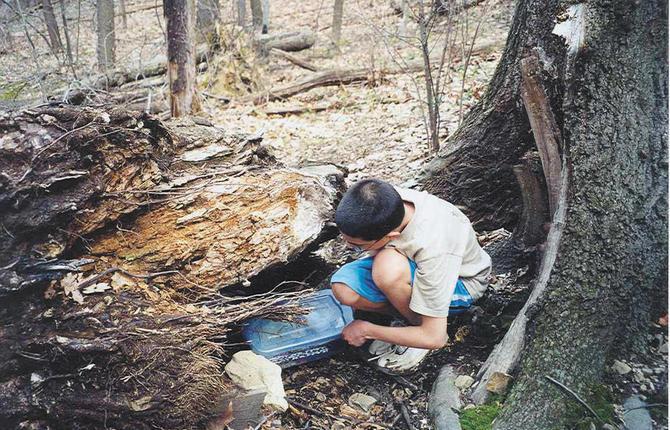
Geocaching – a sport that is ”caching” on
The 10- year- old looks at the small gully, glances down at her hand- held Global Positioning System (GPS) then, with her head up, jumps over the ditch and runs up the hill. According to her coordinates, she is “arriving at her destination.” She peers under a pile of brush. No, it isn’t there. She rounds a tree, looks under a fallen log. No, not there either. Wait. There is a bunch of rock, piled rather suspiciously. Did she see a tiny patch of blue? She bends down, moves the rock and spies it! Success is hers; she found the cache, the geocache that is. “I found it,” she yells as she pulls out the container. Her companions run over to share in the booty of the cache.
She is taking part in one of the fastest growing adventures around, geocaching. Geocaching (pronounced geo-cashing) is a relatively new sport where participants use Global Positioning System Units (GPS) combined with hiking to find caches. A cache is a container filled with goodies – things like key chains, pins, toys and coins. There are also log books in each cache to record finds. In other words, geocaching is a modern day treasure hunt and a perfect sport for families.
There are now over 572,000 caches located in over 300 countries world- wide. A quick search on the official geocaching Web site, www.geocaching.com shows over 3,400 caches in the 416 area code alone!
According to the “official” geocaching Web site (www.geocaching.com), geocaching began in 2000. Restrictions were lifted that had prevented civilians from utilizing GPS’s. While many folks have GPS units in their cars, geocachers use hand held GPS units, usually the size of a cell phone.
Days after the restrictions were lifted; David Ulmer thought it would be cool to hide a cache in Oregon. Within a day, another guy, Mike Teague, found it! Thus geocaching was born. Teague created a basic Web site that later developed into www.geocaching.com.
Follow the arrow
The concept behind a GPS may sound a little tricky. To track your position, it communicates with at least four of 12 satellites that circle the globe. Not only can the GPS tell location, but, by entering the latitude and longitude coordinates of a particular spot – in this case a cache — it can lead to a destination by simply following a directional arrow.
Prior to caching, a geocacher logs onto the official Web site to locate caches. Using the coordinates, the cachers track the caches. Cachers also use logging names, nicknames describing their personalities or other traits.
In addition to knick knacks, some folks put travel bugs in caches. Not an actual creepy, crawly bug, the travel bug is a dog tag engraved with an illustration of a bug and an identification number. The number is tracked through the Web site as the bug moves from cache to cache – around the state, around the country and sometimes even around the world.
John Hinderliter not only caches but likes to introduce others to the sport. He has been caching for almost six years. “I read a little blurb about it and researched it online.” he said. “I have led geocaching hikes for clubs and I always encourage folks to bring their kids as they love a good treasure hunt and are usually better at figuring out the GPS units than their parents.” As he mentions, that is another great aspect of geocaching – it appeals to all ages and all ability levels. There are easy to find caches as well as caches that require kayaking, repelling and even scuba diving to find.
Geocaching is fairly easy and inexpensive. All you need to get started is a GPS — prices start at around $100 – and access to a computer. For more information, visit the official geocaching website at www.geocaching.com or read Geocaching by Erik Sherman (Apress, $19.99) and Geocaching for Idiots by the editors and staff of Geocaching.com and Jack W. Peters (Alpha, $16.95). There is also a DVD on geocaching, The Complete Guide to Geocaching available at www.geocachingvideo.com.
* Kathleen Ganster (a.k.a. Lady Bug Lady) geocaches with friends and family all over the world. She may be reached at ganster@connecttime.net.







